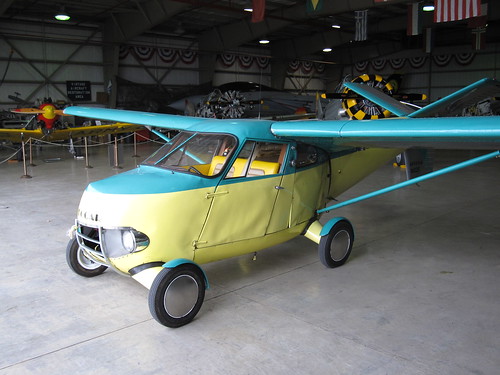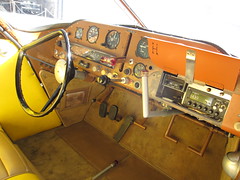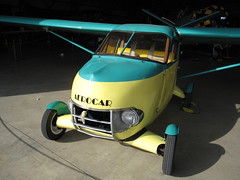Visit the Car Show on November 20th and see the Aerocar!
 This aircraft car was the vision of the future for its designer, Moulton (Molt) Taylor.In 1946, during a trip to Delaware he met inventor Robert E. Fulton, Jr., and became captivated by the concept of his roadable airplane, the Airphibian. Molt immediately saw the weakness in the fixed, detachable wings of Fulton’s design, and set about building his prototype Aerocar with folding wings, which he completed in 1949. After a successful demonstration flight, Molt promoted the Aerocar at aircraft and auto shows and on TV. As the flood of inquiries poured in, Molt raised money to certify the machine as an airplane, and to build four “pre-production” Aerocars for demonstrations and eventual sale.
This aircraft car was the vision of the future for its designer, Moulton (Molt) Taylor.In 1946, during a trip to Delaware he met inventor Robert E. Fulton, Jr., and became captivated by the concept of his roadable airplane, the Airphibian. Molt immediately saw the weakness in the fixed, detachable wings of Fulton’s design, and set about building his prototype Aerocar with folding wings, which he completed in 1949. After a successful demonstration flight, Molt promoted the Aerocar at aircraft and auto shows and on TV. As the flood of inquiries poured in, Molt raised money to certify the machine as an airplane, and to build four “pre-production” Aerocars for demonstrations and eventual sale.
N102D (1960) is yellow and green. It is the last Aerocar built and the only one still flying. This plane is owned by Ed Sweeney and is often on display at the Kissimmee Air Museum located at the Kissimmee Gateway Airport in Kissimmee, Florida.
TAYLOR AEROCAR DESIGN and CONSTRUCTION
The frame, wings and tail are made from riveted aluminum sheet. Corrugated aluminum is used for the aileron skins. Each wing is braced with a streamlined steel strut. The outer fuselage skin panels are made of fiberglass. The engine mount is in line with the rear wheels. The stabilizers and elevators are mounted in a shallow “V”, while the fin and rudder project down from the tail cone to simplify wing folding and to protect the propeller on landing and take-off. For the Aerocar to perform its separate functions from a single engine, the car portion is driven through a fluid drive to the front wheels, and a shaft runs aft from the Flexidyne unit to the propeller.
CONVERSION FROM AIRPLANE TO CAR
After the Aerocar has landed, a brace can be pulled down from each wing tip, and small wheels can be extended out from the leading edges of the wing roots. As each wing is folded back along-side the tail, the aileron automatically folds back to give clearance for the stabilizer and elevator on that side. The tail is then disengaged from the car portion and turned 180 degrees so the wing tips can be attached to a bracket on the back of the car. All this can be accomplished in about three minutes!
CONTROL SYSTEM
 A conventional automotive steering wheel is linked to the front wheels for directional control on the ground, and to ailerons and elevators for bank and pitch control in the air. Just under the engine are connections that meet with the tail cone to actuate the ailerons and rudder. The latter is controlled by pedals on the floor, mounted on either side of conventional clutch and brake pedals. A large white knob on the dashboard controls the throttle.
A conventional automotive steering wheel is linked to the front wheels for directional control on the ground, and to ailerons and elevators for bank and pitch control in the air. Just under the engine are connections that meet with the tail cone to actuate the ailerons and rudder. The latter is controlled by pedals on the floor, mounted on either side of conventional clutch and brake pedals. A large white knob on the dashboard controls the throttle.
FUEL SYSTEM
Fuel is carried in a central 24-gallon tank above the engine, which is gravity-fed. An electric gauge on the dashboard shows the fuel quantity.
ELECTRICAL SYSTEM
The Aerocar uses a generator and 12V battery to drive its electrical system. It has an electric starter for the engine and provision for interior lights as well as headlights.
 LANDING GEAR
LANDING GEAR
The Aerocar has four wheels in either the car or airplane configuration. It lands on the rear wheels and steering is taken over by the front wheels as soon as they touch the ground. In the Model I the landing gears are fixed, but they can be retracted somewhat in the Model III for improved aerodynamics and cruise speed.
Notes from: http://www.airventuremuseum.org/

